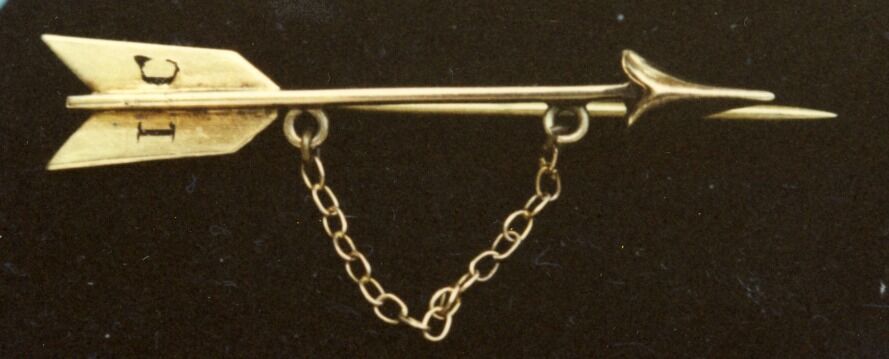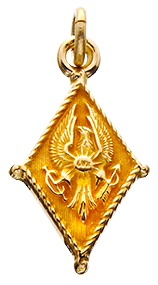the badge
Pi Beta Phi's golden arrow is considered "the outward and visible sign of the inward and spiritual grace that has placed its approval upon nothing short of the true, honest, just, pure, lovely."
Pi Beta Phi's golden arrow is considered "the outward and visible sign of the inward and spiritual grace that has placed its approval upon nothing short of the true, honest, just, pure, lovely."
The decision of the arrow as the official badge of I.C. Sorosis was not a hasty one. The founders deemed this decision so important, they met many times to discuss it. As Ada Bruen Grier said, “Finally, the arrow was decided upon as the most desirable symbol for our clan.” This decision was made on May 5, 1867, and that same day pins were ordered from Wilson Lusk, a jeweler in Monmouth, Illinois.
 The first interpretation of the badge was a golden arrow with a golden chain and the letters “IC” on the wings of the arrow. The pins arrived a little over a week after being ordered and the Founders went to chapel that next day wearing their arrows in their hair. That’s right — their hair! While today Pi Phi’s wear their “A-R-R-O-W o’er your H-E-A-R-T,” it wasn't always that way. Emma Brownlee Kilgore reported, “It was a long-to-be-remembered event. The young men cheered, the faculty smiled, and we felt that it was truly an important occasion.”
The first interpretation of the badge was a golden arrow with a golden chain and the letters “IC” on the wings of the arrow. The pins arrived a little over a week after being ordered and the Founders went to chapel that next day wearing their arrows in their hair. That’s right — their hair! While today Pi Phi’s wear their “A-R-R-O-W o’er your H-E-A-R-T,” it wasn't always that way. Emma Brownlee Kilgore reported, “It was a long-to-be-remembered event. The young men cheered, the faculty smiled, and we felt that it was truly an important occasion.”
Until 1888, the pin bore upon its wing the letters “IC” in black enamel and was longer than the present 1-inch size. A guard pin was used before the safety catch was invented. This guard was of gold, either a Greek letter, the same as the name of the chapter to which the owner belonged, or “IC.” In 1888, when the name was changed to Pi Beta Phi, the Greek letters replaced the “IC” on the wings of the badge. Until that time, the badge was unadorned. After the name change from I.C. Sorosis to Pi Beta Phi, the subject of jeweled badges arose. The first jeweled Pi Beta Phi badge was presented by the Fraternity to Grand President Rainie Adamson Small. She presided over the 1888 Ottumwa Convention when the name of I.C. Sorosis officially became its Greek motto, Pi Beta Phi.
 Significant decisions about the badge were made at various conventions through the years. The Founders did indeed first wear their badges in their hair, and pictures from the archives show the pin was also worn on high neck collars and on either side of the bodice and sometimes pointing downward. But, a vote at the 1906 Indianapolis Convention designated the badge should be worn on the left side of the bodice near the heart pointing upward. It was at this time that the giving of Pi Phi jewelry to any man was prohibited. The 1921 Charlevoix Convention body noted that no initiated member at the time or initiated after July 6, 1921, wear anything other than the official standard, gold badge — enameled wings and stones in the chains were forbidden. At the 1934 Yellowstone Convention the decision was made to replace the previously woven chain with a linked chain of 12 links — one for each of the founders.
Significant decisions about the badge were made at various conventions through the years. The Founders did indeed first wear their badges in their hair, and pictures from the archives show the pin was also worn on high neck collars and on either side of the bodice and sometimes pointing downward. But, a vote at the 1906 Indianapolis Convention designated the badge should be worn on the left side of the bodice near the heart pointing upward. It was at this time that the giving of Pi Phi jewelry to any man was prohibited. The 1921 Charlevoix Convention body noted that no initiated member at the time or initiated after July 6, 1921, wear anything other than the official standard, gold badge — enameled wings and stones in the chains were forbidden. At the 1934 Yellowstone Convention the decision was made to replace the previously woven chain with a linked chain of 12 links — one for each of the founders.
In 1921, it was also decided the fraternity pins of husbands, fathers, brothers, sons and fiancés could be attached by a chain to the arrow, if desired. A pin with the monogram of the Greek Pi Beta Phi letters was known as the Pi Beta Phi Brother Pin was manufactured. Brothers, fiancés and husbands of Pi Beta Phi women could wear this pin. At the 2011 Convention, legislation passed to discontinue the use of the Pi Beta Phi Brother Pin.
Upon initiation into Pi Beta Phi, a member is given a gold-filled badge. If she wishes, she may order a jeweled badge through Herff Jones, the official Pi Beta Phi jeweler. Article XVIII, Section 2, of the Pi Beta Phi Statutes states:
The badge, which shall be worn on the left side near the heart, shall be a golden arrow, bearing the Greek letters Pi Beta Phi transversely on its feather, with a loop chain of 12 links pendent from the shaft.
 There have been many “official jewelers” of the Pi Beta Phi badge throughout the years. The first badges were ordered from Wilson Lusk, a jeweler in Monmouth. Twenty-one years later at the 1888 Ottumwa Convention, Michigan Beta was assigned the task of purchasing the badges from John F. Newman, a fraternity jeweler in New York City. At the 1895 Boston Convention, Trask and Plain of Galesburg, Illinois, and Simons Brothers and Company of Philadelphia, were accepted as official Fraternity jewelers. The 1897 Madison Convention authorized “a fine to be imposed upon any member for securing a pin not manufactured by an official jeweler.” This was due in part to the number of unreliable firms, which had entered the fraternity jewelry field. At the 1912 Evanston Convention, members voted for only one maker of the badge. After a year’s consideration of bids and samples, the L.G. Balfour Company of Attleboro, Massachusetts, was awarded the contract.
There have been many “official jewelers” of the Pi Beta Phi badge throughout the years. The first badges were ordered from Wilson Lusk, a jeweler in Monmouth. Twenty-one years later at the 1888 Ottumwa Convention, Michigan Beta was assigned the task of purchasing the badges from John F. Newman, a fraternity jeweler in New York City. At the 1895 Boston Convention, Trask and Plain of Galesburg, Illinois, and Simons Brothers and Company of Philadelphia, were accepted as official Fraternity jewelers. The 1897 Madison Convention authorized “a fine to be imposed upon any member for securing a pin not manufactured by an official jeweler.” This was due in part to the number of unreliable firms, which had entered the fraternity jewelry field. At the 1912 Evanston Convention, members voted for only one maker of the badge. After a year’s consideration of bids and samples, the L.G. Balfour Company of Attleboro, Massachusetts, was awarded the contract.
The Fraternity felt the need to better regulate the sale of badges and in 1914, Grand Council created the office of custodian of the pin. Her job was to issue all orders for badges brought by any except initiated members, take charge of all unclaimed badges and badges of deceased members, and receive from chapter presidents reports of all badges purchased by initiated members.
Replicas of other designs are used as honor badges. A large gold-winged arrow is used for a director’s badge, and a large white-winged arrow is used to note service on Grand Council. The distinguishing badge for a member of the Silver Arrow Society, which recognizes 25-year membership in Pi Beta Phi, is a silver-tone and diamond-shaped pin with a center, bevel-cut arrow. The Order of the Golden Arrow was established at the 1946 Swampscott Convention. In 1952, a carnation pin to be worn by Golden Arrows made its debut. At the 1987 New Orleans Convention, legislation made way for a new Golden Arrow pin. It is a gold circle pin crossed by an arrow. The new design allowed for a larger pin back and ease of pinning.
Members’ reverence to the Pi Beta Phi badge is felt in many Fraternity songs, including “I’m a P,” “Remember” and “One, Two, Three Words.”